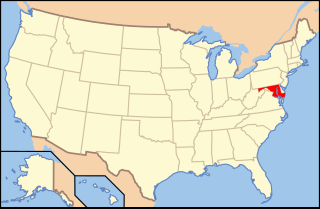
Ecphora is the common name for a group of extinct predatory marine gastropod mollusks within the family Muricidae, the rocks snails or murexes. The common name is based on the first officially described genus, Ecphora. The entire lineage of these ocenebrinid murexes are descended from the Eocene murex, Tritonopsis. Ecphoras were indigenous to the North American Eastern Seaboard, being found in marine strata from the Late Eocene until their extinction during the Pliocene. Many ecphora species are important index fossils.

Julia Anna Gardner, was an American geologist who worked for the United States Geological Survey for 32 years. She was known worldwide for her work in stratigraphy and mollusc paleontology.

Paleontology in Maryland refers to paleontological research occurring within or conducted by people from the U.S. state of Maryland. The invertebrate fossils of Maryland are similar to those of neighboring Delaware. For most of the early Paleozoic era, Maryland was covered by a shallow sea, although it was above sea level for portions of the Ordovician and Devonian. The ancient marine life of Maryland included brachiopods and bryozoans while horsetails and scale trees grew on land. By the end of the era, the sea had left the state completely. In the early Mesozoic, Pangaea was splitting up. The same geologic forces that divided the supercontinent formed massive lakes. Dinosaur footprints were preserved along their shores. During the Cretaceous, the state was home to dinosaurs. During the early part of the Cenozoic era, the state was alternatingly submerged by sea water or exposed. During the Ice Age, mastodons lived in the state.

Ecphora is a genus of extinct predatory ocenebrinid murexes indigenous to the North American Eastern Seaboard from Miocene until their extinction during the Pliocene. The common name for this genus and a group of related genera is "ecphora"(s).
Trisecphora is a genus of extinct predatory ocenebrinid murexes indigenous to the Miocene coastline of what is now Maryland, North Carolina, and Virginia from the Aquitanian epoch until their extinction near the end of the Serravallian epoch. The common name for this genus and their relatives is "ecphora"(s).
Inodrillia whitfieldi is an extinct species of sea snail, a marine gastropod mollusk in the family Horaiclavidae.
Mangelia gardnerae is a minute extinct species of sea snail, a marine gastropod mollusk in the family Mangeliidae.
Carinodrillia elocata is an extinct species of sea snail, a marine gastropod mollusk in the family Pseudomelatomidae, the turrids and allies.
Compsodrillia drewi is an extinct species of sea snail, a marine gastropod mollusk in the family Pseudomelatomidae, the turrids and allies.
Crassispira cymation is an extinct species of sea snail, a marine gastropod mollusk in the family Pseudomelatomidae, the turrids and allies.
Crassispira tyloessa is an extinct species of sea snail, a marine gastropod mollusk in the family Pseudomelatomidae, the turrids and allies.
Crassispira perrugata is an extinct species of sea snail, a marine gastropod mollusk in the family Pseudomelatomidae, the turrids and allies.
Crassispira promensis is an extinct species of sea snail, a marine gastropod mollusk in the family Pseudomelatomidae, the turrids and allies.
Hindsiclava henekeni is an extinct species of sea snail, a marine gastropod mollusc in the family Pseudomelatomidae, the turrids and allies.
Leucosyrinx rugata is an extinct species of sea snail, a marine gastropod mollusk in the family Pseudomelatomidae, the turrids and allies.
Conasprella burckhardti is an extinct species of sea snail, a marine gastropod mollusk in the family Conidae, the cone snails and their allies.
Sediliopsis angulata is an extinct species of sea snail, a marine gastropod mollusk in the family Pseudomelatomidae, the turrids and allies.
Daphnella pagera is an extinct species of sea snail, a marine gastropod mollusc in the family Raphitomidae.
Urosalpinx rusticus is an extinct species of sea snail, a marine gastropod mollusk in the family Muricidae, the murex snails or rock snails.
Urosalpinx subrusticus is an extinct species of sea snail, a marine gastropod mollusk in the family Muricidae, the murex snails or rock snails.




